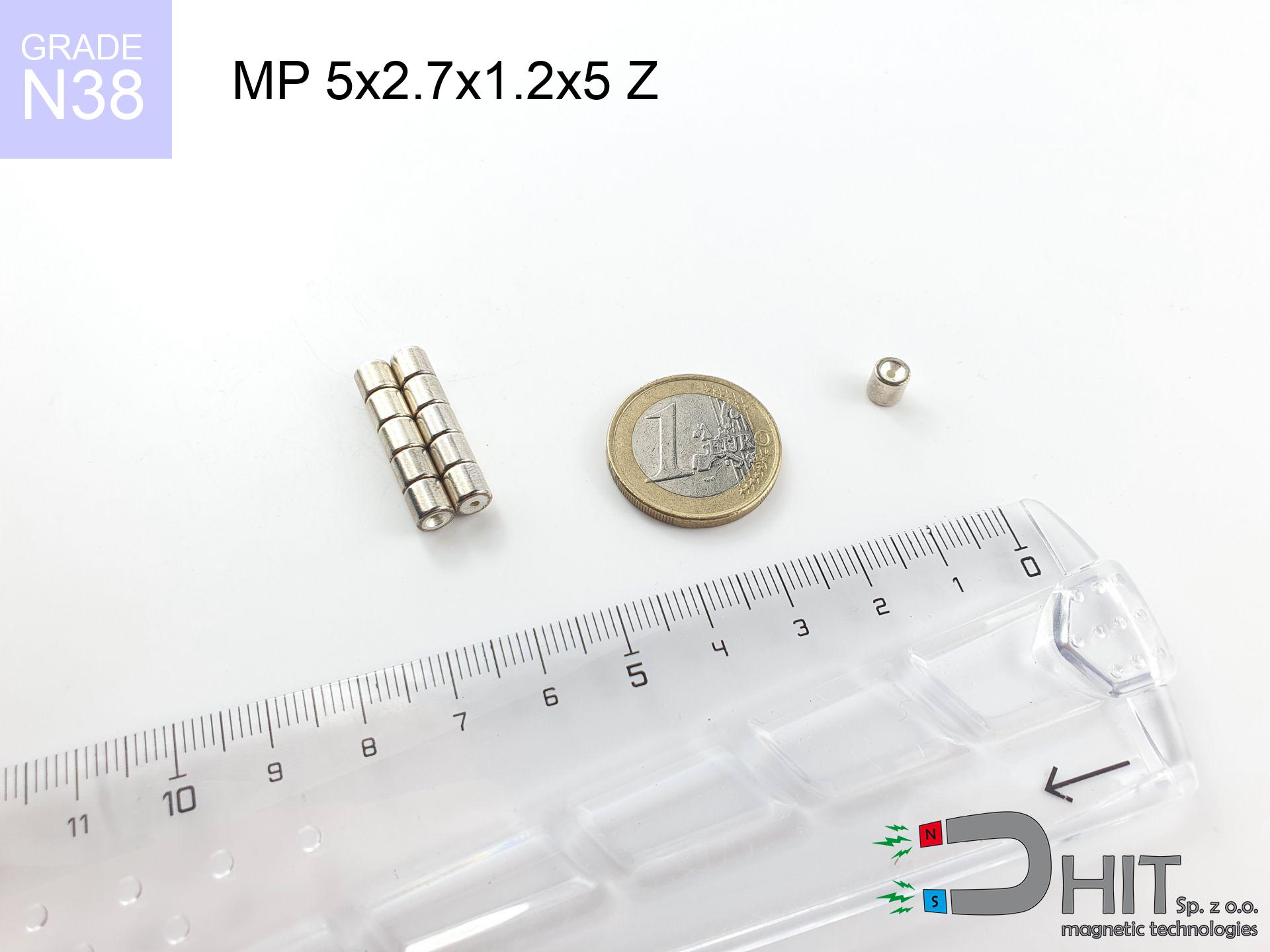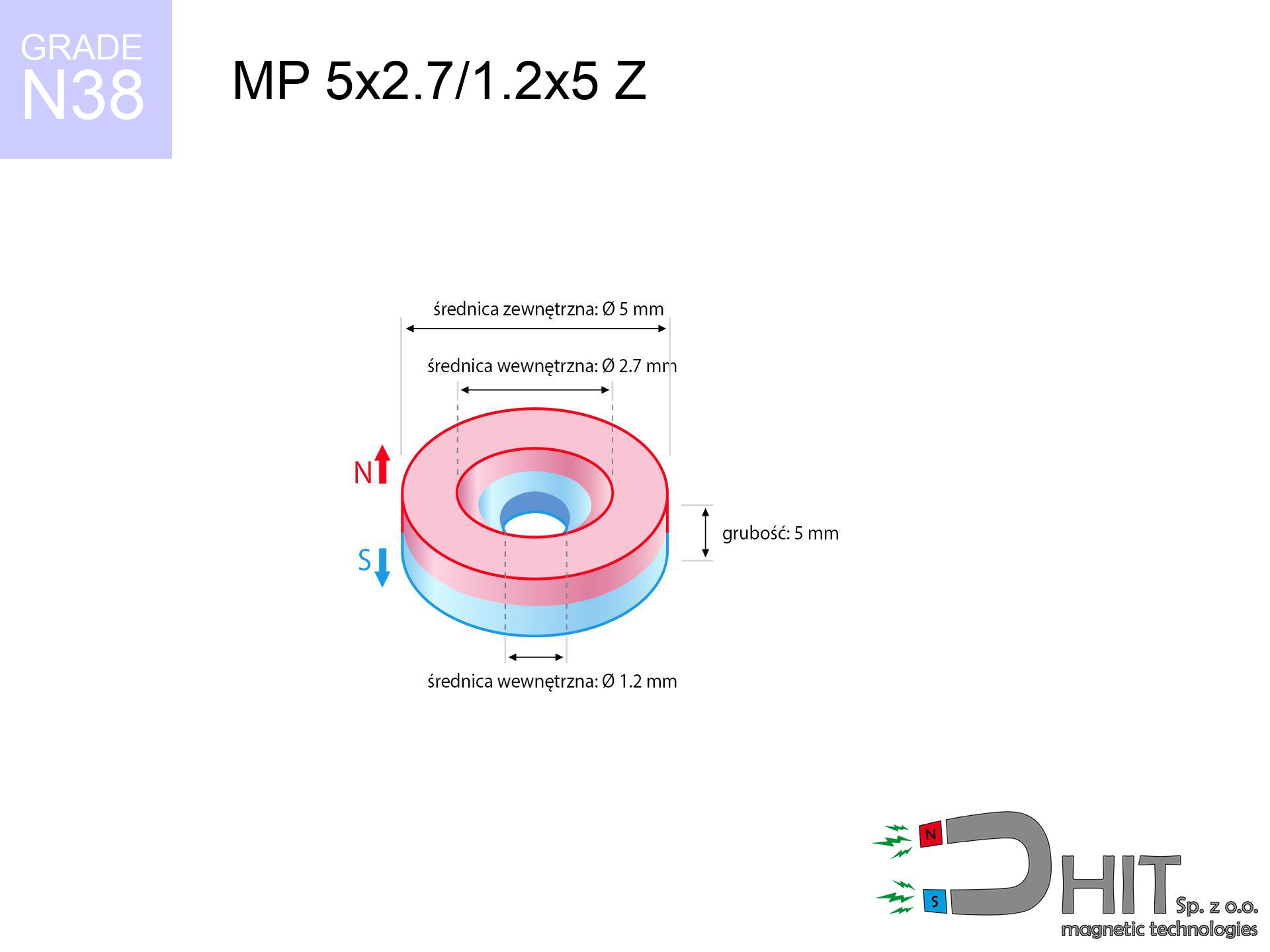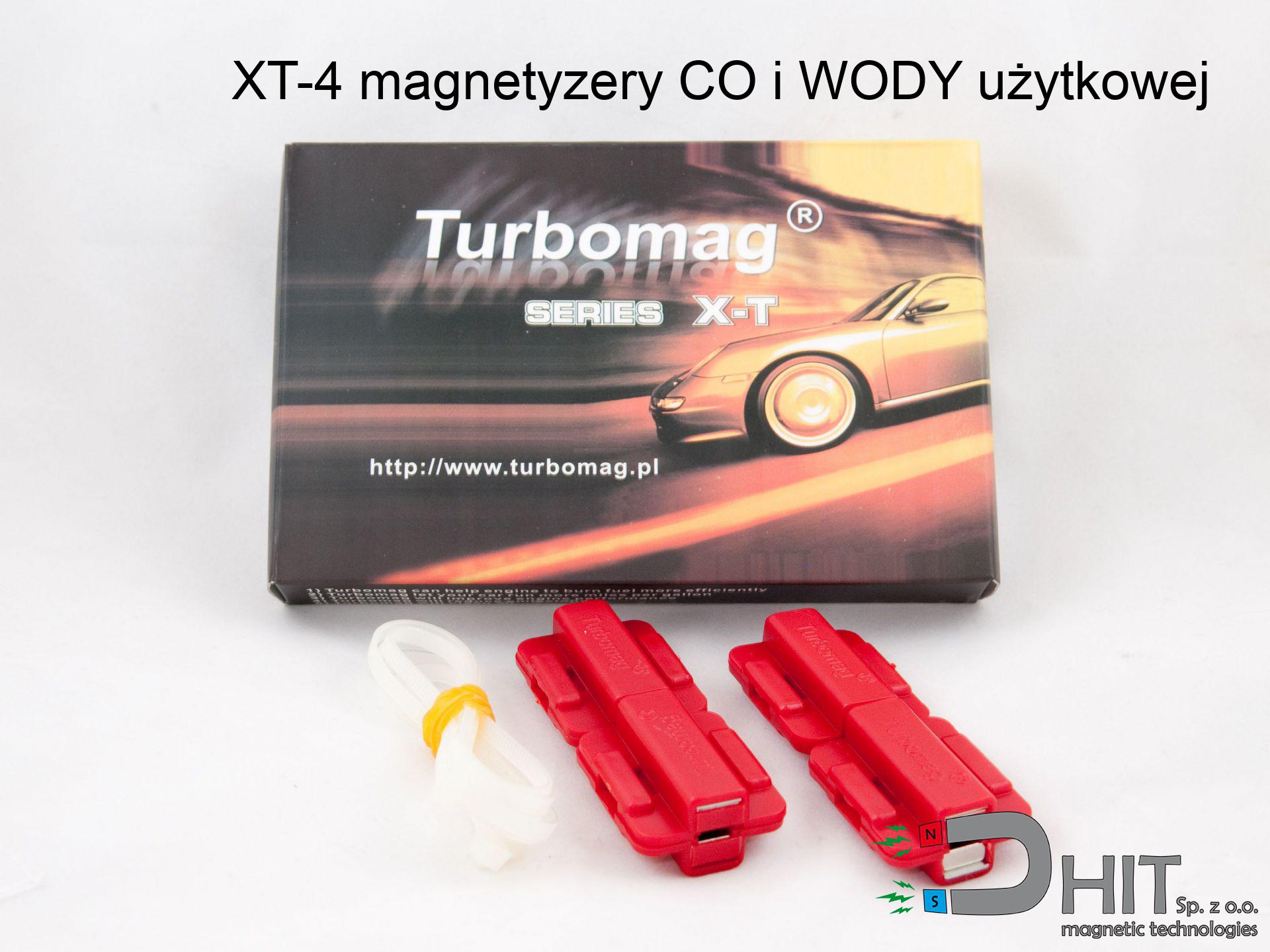MP 5x2.7/1.2x5 Z / N38 - ring magnet
ring magnet
Catalog no 030203
GTIN/EAN: 5906301812203
Diameter
5 mm [±0,1 mm]
internal diameter Ø
2.7/1.2 mm [±0,1 mm]
Height
5 mm [±0,1 mm]
Weight
0.69 g
Magnetization Direction
↑ axial
Load capacity
0.75 kg / 7.31 N
Magnetic Induction
553.14 mT / 5531 Gs
Coating
[NiCuNi] Nickel
0.836 ZŁ with VAT / pcs + price for transport
0.680 ZŁ net + 23% VAT / pcs
bulk discounts:
Need more?
Call us
+48 22 499 98 98
otherwise get in touch via
request form
through our site.
Lifting power and structure of magnetic components can be reviewed with our
power calculator.
Orders submitted before 14:00 will be dispatched today!
Technical details - MP 5x2.7/1.2x5 Z / N38 - ring magnet
Specification / characteristics - MP 5x2.7/1.2x5 Z / N38 - ring magnet
| properties | values |
|---|---|
| Cat. no. | 030203 |
| GTIN/EAN | 5906301812203 |
| Production/Distribution | Dhit sp. z o.o. |
| Country of origin | Poland / China / Germany |
| Customs code | 85059029 |
| Diameter | 5 mm [±0,1 mm] |
| internal diameter Ø | 2.7/1.2 mm [±0,1 mm] |
| Height | 5 mm [±0,1 mm] |
| Weight | 0.69 g |
| Magnetization Direction | ↑ axial |
| Load capacity ~ ? | 0.75 kg / 7.31 N |
| Magnetic Induction ~ ? | 553.14 mT / 5531 Gs |
| Coating | [NiCuNi] Nickel |
| Manufacturing Tolerance | ±0.1 mm |
Magnetic properties of material N38
| properties | values | units |
|---|---|---|
| remenance Br [min. - max.] ? | 12.2-12.6 | kGs |
| remenance Br [min. - max.] ? | 1220-1260 | mT |
| coercivity bHc ? | 10.8-11.5 | kOe |
| coercivity bHc ? | 860-915 | kA/m |
| actual internal force iHc | ≥ 12 | kOe |
| actual internal force iHc | ≥ 955 | kA/m |
| energy density [min. - max.] ? | 36-38 | BH max MGOe |
| energy density [min. - max.] ? | 287-303 | BH max KJ/m |
| max. temperature ? | ≤ 80 | °C |
Physical properties of sintered neodymium magnets Nd2Fe14B at 20°C
| properties | values | units |
|---|---|---|
| Vickers hardness | ≥550 | Hv |
| Density | ≥7.4 | g/cm3 |
| Curie Temperature TC | 312 - 380 | °C |
| Curie Temperature TF | 593 - 716 | °F |
| Specific resistance | 150 | μΩ⋅cm |
| Bending strength | 250 | MPa |
| Compressive strength | 1000~1100 | MPa |
| Thermal expansion parallel (∥) to orientation (M) | (3-4) x 10-6 | °C-1 |
| Thermal expansion perpendicular (⊥) to orientation (M) | -(1-3) x 10-6 | °C-1 |
| Young's modulus | 1.7 x 104 | kg/mm² |
Engineering analysis of the assembly - data
These data are the direct effect of a mathematical analysis. Results were calculated on models for the material Nd2Fe14B. Real-world parameters might slightly differ. Treat these calculations as a preliminary roadmap for designers.
Table 1: Static force (force vs gap) - characteristics
MP 5x2.7/1.2x5 Z / N38
| Distance (mm) | Induction (Gauss) / mT | Pull Force (kg/lbs/g/N) | Risk Status |
|---|---|---|---|
| 0 mm |
5322 Gs
532.2 mT
|
0.75 kg / 1.65 pounds
750.0 g / 7.4 N
|
safe |
| 1 mm |
3295 Gs
329.5 mT
|
0.29 kg / 0.63 pounds
287.5 g / 2.8 N
|
safe |
| 2 mm |
1883 Gs
188.3 mT
|
0.09 kg / 0.21 pounds
93.9 g / 0.9 N
|
safe |
| 3 mm |
1098 Gs
109.8 mT
|
0.03 kg / 0.07 pounds
31.9 g / 0.3 N
|
safe |
| 5 mm |
440 Gs
44.0 mT
|
0.01 kg / 0.01 pounds
5.1 g / 0.1 N
|
safe |
| 10 mm |
92 Gs
9.2 mT
|
0.00 kg / 0.00 pounds
0.2 g / 0.0 N
|
safe |
| 15 mm |
33 Gs
3.3 mT
|
0.00 kg / 0.00 pounds
0.0 g / 0.0 N
|
safe |
| 20 mm |
15 Gs
1.5 mT
|
0.00 kg / 0.00 pounds
0.0 g / 0.0 N
|
safe |
| 30 mm |
5 Gs
0.5 mT
|
0.00 kg / 0.00 pounds
0.0 g / 0.0 N
|
safe |
| 50 mm |
1 Gs
0.1 mT
|
0.00 kg / 0.00 pounds
0.0 g / 0.0 N
|
safe |
Table 2: Vertical capacity (vertical surface)
MP 5x2.7/1.2x5 Z / N38
| Distance (mm) | Friction coefficient | Pull Force (kg/lbs/g/N) |
|---|---|---|
| 0 mm | Stal (~0.2) |
0.15 kg / 0.33 pounds
150.0 g / 1.5 N
|
| 1 mm | Stal (~0.2) |
0.06 kg / 0.13 pounds
58.0 g / 0.6 N
|
| 2 mm | Stal (~0.2) |
0.02 kg / 0.04 pounds
18.0 g / 0.2 N
|
| 3 mm | Stal (~0.2) |
0.01 kg / 0.01 pounds
6.0 g / 0.1 N
|
| 5 mm | Stal (~0.2) |
0.00 kg / 0.00 pounds
2.0 g / 0.0 N
|
| 10 mm | Stal (~0.2) |
0.00 kg / 0.00 pounds
0.0 g / 0.0 N
|
| 15 mm | Stal (~0.2) |
0.00 kg / 0.00 pounds
0.0 g / 0.0 N
|
| 20 mm | Stal (~0.2) |
0.00 kg / 0.00 pounds
0.0 g / 0.0 N
|
| 30 mm | Stal (~0.2) |
0.00 kg / 0.00 pounds
0.0 g / 0.0 N
|
| 50 mm | Stal (~0.2) |
0.00 kg / 0.00 pounds
0.0 g / 0.0 N
|
Table 3: Vertical assembly (shearing) - vertical pull
MP 5x2.7/1.2x5 Z / N38
| Surface type | Friction coefficient / % Mocy | Max load (kg/lbs/g/N) |
|---|---|---|
| Raw steel |
µ = 0.3
30% Nominalnej Siły
|
0.22 kg / 0.50 pounds
225.0 g / 2.2 N
|
| Painted steel (standard) |
µ = 0.2
20% Nominalnej Siły
|
0.15 kg / 0.33 pounds
150.0 g / 1.5 N
|
| Oily/slippery steel |
µ = 0.1
10% Nominalnej Siły
|
0.08 kg / 0.17 pounds
75.0 g / 0.7 N
|
| Magnet with anti-slip rubber |
µ = 0.5
50% Nominalnej Siły
|
0.38 kg / 0.83 pounds
375.0 g / 3.7 N
|
Table 4: Material efficiency (substrate influence) - power losses
MP 5x2.7/1.2x5 Z / N38
| Steel thickness (mm) | % power | Real pull force (kg/lbs/g/N) |
|---|---|---|
| 0.5 mm |
|
0.08 kg / 0.17 pounds
75.0 g / 0.7 N
|
| 1 mm |
|
0.19 kg / 0.41 pounds
187.5 g / 1.8 N
|
| 2 mm |
|
0.38 kg / 0.83 pounds
375.0 g / 3.7 N
|
| 3 mm |
|
0.56 kg / 1.24 pounds
562.5 g / 5.5 N
|
| 5 mm |
|
0.75 kg / 1.65 pounds
750.0 g / 7.4 N
|
| 10 mm |
|
0.75 kg / 1.65 pounds
750.0 g / 7.4 N
|
| 11 mm |
|
0.75 kg / 1.65 pounds
750.0 g / 7.4 N
|
| 12 mm |
|
0.75 kg / 1.65 pounds
750.0 g / 7.4 N
|
Table 5: Working in heat (material behavior) - resistance threshold
MP 5x2.7/1.2x5 Z / N38
| Ambient temp. (°C) | Power loss | Remaining pull (kg/lbs/g/N) | Status |
|---|---|---|---|
| 20 °C | 0.0% |
0.75 kg / 1.65 pounds
750.0 g / 7.4 N
|
OK |
| 40 °C | -2.2% |
0.73 kg / 1.62 pounds
733.5 g / 7.2 N
|
OK |
| 60 °C | -4.4% |
0.72 kg / 1.58 pounds
717.0 g / 7.0 N
|
OK |
| 80 °C | -6.6% |
0.70 kg / 1.54 pounds
700.5 g / 6.9 N
|
|
| 100 °C | -28.8% |
0.53 kg / 1.18 pounds
534.0 g / 5.2 N
|
Table 6: Two magnets (repulsion) - forces in the system
MP 5x2.7/1.2x5 Z / N38
| Gap (mm) | Attraction (kg/lbs) (N-S) | Shear Force (kg/lbs/g/N) | Repulsion (kg/lbs) (N-N) |
|---|---|---|---|
| 0 mm |
2.75 kg / 6.06 pounds
5 924 Gs
|
0.41 kg / 0.91 pounds
412 g / 4.0 N
|
N/A |
| 1 mm |
1.77 kg / 3.90 pounds
8 541 Gs
|
0.27 kg / 0.58 pounds
265 g / 2.6 N
|
1.59 kg / 3.51 pounds
~0 Gs
|
| 2 mm |
1.05 kg / 2.32 pounds
6 590 Gs
|
0.16 kg / 0.35 pounds
158 g / 1.5 N
|
0.95 kg / 2.09 pounds
~0 Gs
|
| 3 mm |
0.60 kg / 1.33 pounds
4 992 Gs
|
0.09 kg / 0.20 pounds
91 g / 0.9 N
|
0.54 kg / 1.20 pounds
~0 Gs
|
| 5 mm |
0.20 kg / 0.44 pounds
2 860 Gs
|
0.03 kg / 0.07 pounds
30 g / 0.3 N
|
0.18 kg / 0.39 pounds
~0 Gs
|
| 10 mm |
0.02 kg / 0.04 pounds
880 Gs
|
0.00 kg / 0.01 pounds
3 g / 0.0 N
|
0.02 kg / 0.04 pounds
~0 Gs
|
| 20 mm |
0.00 kg / 0.00 pounds
184 Gs
|
0.00 kg / 0.00 pounds
0 g / 0.0 N
|
0.00 kg / 0.00 pounds
~0 Gs
|
| 50 mm |
0.00 kg / 0.00 pounds
16 Gs
|
0.00 kg / 0.00 pounds
0 g / 0.0 N
|
0.00 kg / 0.00 pounds
~0 Gs
|
| 60 mm |
0.00 kg / 0.00 pounds
10 Gs
|
0.00 kg / 0.00 pounds
0 g / 0.0 N
|
0.00 kg / 0.00 pounds
~0 Gs
|
| 70 mm |
0.00 kg / 0.00 pounds
6 Gs
|
0.00 kg / 0.00 pounds
0 g / 0.0 N
|
0.00 kg / 0.00 pounds
~0 Gs
|
| 80 mm |
0.00 kg / 0.00 pounds
4 Gs
|
0.00 kg / 0.00 pounds
0 g / 0.0 N
|
0.00 kg / 0.00 pounds
~0 Gs
|
| 90 mm |
0.00 kg / 0.00 pounds
3 Gs
|
0.00 kg / 0.00 pounds
0 g / 0.0 N
|
0.00 kg / 0.00 pounds
~0 Gs
|
| 100 mm |
0.00 kg / 0.00 pounds
2 Gs
|
0.00 kg / 0.00 pounds
0 g / 0.0 N
|
0.00 kg / 0.00 pounds
~0 Gs
|
Table 7: Hazards (implants) - warnings
MP 5x2.7/1.2x5 Z / N38
| Object / Device | Limit (Gauss) / mT | Safe distance |
|---|---|---|
| Pacemaker | 5 Gs (0.5 mT) | 3.0 cm |
| Hearing aid | 10 Gs (1.0 mT) | 2.5 cm |
| Mechanical watch | 20 Gs (2.0 mT) | 2.0 cm |
| Mobile device | 40 Gs (4.0 mT) | 1.5 cm |
| Remote | 50 Gs (5.0 mT) | 1.5 cm |
| Payment card | 400 Gs (40.0 mT) | 1.0 cm |
| HDD hard drive | 600 Gs (60.0 mT) | 0.5 cm |
Table 8: Collisions (cracking risk) - collision effects
MP 5x2.7/1.2x5 Z / N38
| Start from (mm) | Speed (km/h) | Energy (J) | Predicted outcome |
|---|---|---|---|
| 10 mm |
33.26 km/h
(9.24 m/s)
|
0.03 J | |
| 30 mm |
57.59 km/h
(16.00 m/s)
|
0.09 J | |
| 50 mm |
74.35 km/h
(20.65 m/s)
|
0.15 J | |
| 100 mm |
105.14 km/h
(29.21 m/s)
|
0.29 J |
Table 9: Corrosion resistance
MP 5x2.7/1.2x5 Z / N38
| Technical parameter | Value / Description |
|---|---|
| Coating type | [NiCuNi] Nickel |
| Layer structure | Nickel - Copper - Nickel |
| Layer thickness | 10-20 µm |
| Salt spray test (SST) ? | 24 h |
| Recommended environment | Indoors only (dry) |
Table 10: Construction data (Flux)
MP 5x2.7/1.2x5 Z / N38
| Parameter | Value | SI Unit / Description |
|---|---|---|
| Magnetic Flux | 862 Mx | 8.6 µWb |
| Pc Coefficient | 0.83 | High (Stable) |
Table 11: Physics of underwater searching
MP 5x2.7/1.2x5 Z / N38
| Environment | Effective steel pull | Effect |
|---|---|---|
| Air (land) | 0.75 kg | Standard |
| Water (riverbed) |
0.86 kg
(+0.11 kg buoyancy gain)
|
+14.5% |
1. Sliding resistance
*Caution: On a vertical surface, the magnet holds merely ~20% of its nominal pull.
2. Steel thickness impact
*Thin steel (e.g. computer case) drastically limits the holding force.
3. Heat tolerance
*For N38 grade, the safety limit is 80°C.
4. Demagnetization curve and operating point (B-H)
chart generated for the permeance coefficient Pc (Permeance Coefficient) = 0.83
This simulation demonstrates the magnetic stability of the selected magnet under specific geometric conditions. The solid red line represents the demagnetization curve (material potential), while the dashed blue line is the load line based on the magnet's geometry. The Pc (Permeance Coefficient), also known as the load line slope, is a dimensionless value that describes the relationship between the magnet's shape and its magnetic stability. The intersection of these two lines (the black dot) is the operating point — it determines the actual magnetic flux density generated by the magnet in this specific configuration. A higher Pc value means the magnet is more 'slender' (tall relative to its area), resulting in a higher operating point and better resistance to irreversible demagnetization caused by external fields or temperature. A value of 0.42 is relatively low (typical for flat magnets), meaning the operating point is closer to the 'knee' of the curve — caution is advised when operating at temperatures near the maximum limit to avoid strength loss.
Material specification
| iron (Fe) | 64% – 68% |
| neodymium (Nd) | 29% – 32% |
| boron (B) | 1.1% – 1.2% |
| dysprosium (Dy) | 0.5% – 2.0% |
| coating (Ni-Cu-Ni) | < 0.05% |
Ecology and recycling (GPSR)
| recyclability (EoL) | 100% |
| recycled raw materials | ~10% (pre-cons) |
| carbon footprint | low / zredukowany |
| waste code (EWC) | 16 02 16 |
See also offers
Pros as well as cons of Nd2Fe14B magnets.
Pros
- They do not lose magnetism, even over nearly 10 years – the reduction in power is only ~1% (based on measurements),
- Neodymium magnets remain extremely resistant to demagnetization caused by external magnetic fields,
- In other words, due to the aesthetic surface of silver, the element gains visual value,
- The surface of neodymium magnets generates a strong magnetic field – this is a key feature,
- Through (adequate) combination of ingredients, they can achieve high thermal resistance, allowing for functioning at temperatures reaching 230°C and above...
- Possibility of custom creating as well as optimizing to concrete applications,
- Huge importance in modern technologies – they are used in hard drives, electromotive mechanisms, advanced medical instruments, also complex engineering applications.
- Relatively small size with high pulling force – neodymium magnets offer impressive pulling force in tiny dimensions, which allows their use in compact constructions
Disadvantages
- They are prone to damage upon heavy impacts. To avoid cracks, it is worth protecting magnets in special housings. Such protection not only protects the magnet but also increases its resistance to damage
- We warn that neodymium magnets can reduce their strength at high temperatures. To prevent this, we recommend our specialized [AH] magnets, which work effectively even at 230°C.
- Magnets exposed to a humid environment can rust. Therefore when using outdoors, we suggest using waterproof magnets made of rubber, plastic or other material protecting against moisture
- Limited possibility of making threads in the magnet and complicated forms - preferred is casing - magnetic holder.
- Health risk to health – tiny shards of magnets are risky, in case of ingestion, which gains importance in the context of child safety. Furthermore, tiny parts of these devices are able to disrupt the diagnostic process medical when they are in the body.
- With budget limitations the cost of neodymium magnets is economically unviable,
Pull force analysis
Maximum lifting capacity of the magnet – what affects it?
- using a base made of high-permeability steel, functioning as a magnetic yoke
- with a thickness minimum 10 mm
- with a plane cleaned and smooth
- without any clearance between the magnet and steel
- during detachment in a direction vertical to the plane
- at conditions approx. 20°C
Impact of factors on magnetic holding capacity in practice
- Gap between surfaces – every millimeter of separation (caused e.g. by varnish or dirt) significantly weakens the pulling force, often by half at just 0.5 mm.
- Pull-off angle – remember that the magnet has greatest strength perpendicularly. Under sliding down, the capacity drops drastically, often to levels of 20-30% of the nominal value.
- Wall thickness – the thinner the sheet, the weaker the hold. Part of the magnetic field penetrates through instead of generating force.
- Steel grade – the best choice is high-permeability steel. Cast iron may generate lower lifting capacity.
- Plate texture – smooth surfaces guarantee perfect abutment, which improves field saturation. Uneven metal reduce efficiency.
- Thermal factor – hot environment reduces magnetic field. Too high temperature can permanently damage the magnet.
Holding force was tested on a smooth steel plate of 20 mm thickness, when a perpendicular force was applied, in contrast under shearing force the load capacity is reduced by as much as 75%. In addition, even a slight gap between the magnet and the plate lowers the lifting capacity.
Precautions when working with neodymium magnets
Caution required
Before use, check safety instructions. Sudden snapping can break the magnet or injure your hand. Be predictive.
Power loss in heat
Standard neodymium magnets (grade N) lose power when the temperature exceeds 80°C. Damage is permanent.
Product not for children
Product intended for adults. Tiny parts pose a choking risk, leading to intestinal necrosis. Keep out of reach of kids and pets.
Pinching danger
Pinching hazard: The pulling power is so immense that it can cause blood blisters, crushing, and broken bones. Protective gloves are recommended.
Keep away from electronics
Be aware: rare earth magnets generate a field that interferes with precision electronics. Keep a separation from your mobile, tablet, and GPS.
Risk of cracking
Despite metallic appearance, the material is delicate and cannot withstand shocks. Avoid impacts, as the magnet may crumble into hazardous fragments.
Nickel allergy
It is widely known that the nickel plating (the usual finish) is a strong allergen. If you have an allergy, avoid direct skin contact and choose versions in plastic housing.
Keep away from computers
Device Safety: Strong magnets can damage payment cards and sensitive devices (pacemakers, hearing aids, mechanical watches).
Health Danger
Life threat: Neodymium magnets can turn off heart devices and defibrillators. Stay away if you have electronic implants.
Fire warning
Fire hazard: Rare earth powder is highly flammable. Do not process magnets without safety gear as this risks ignition.






![SM 25x350 [2xM8] / N52 - magnetic separator SM 25x350 [2xM8] / N52 - magnetic separator](https://cdn3.dhit.pl/graphics/products/sm-25x350-2xm8-geb.jpg)


